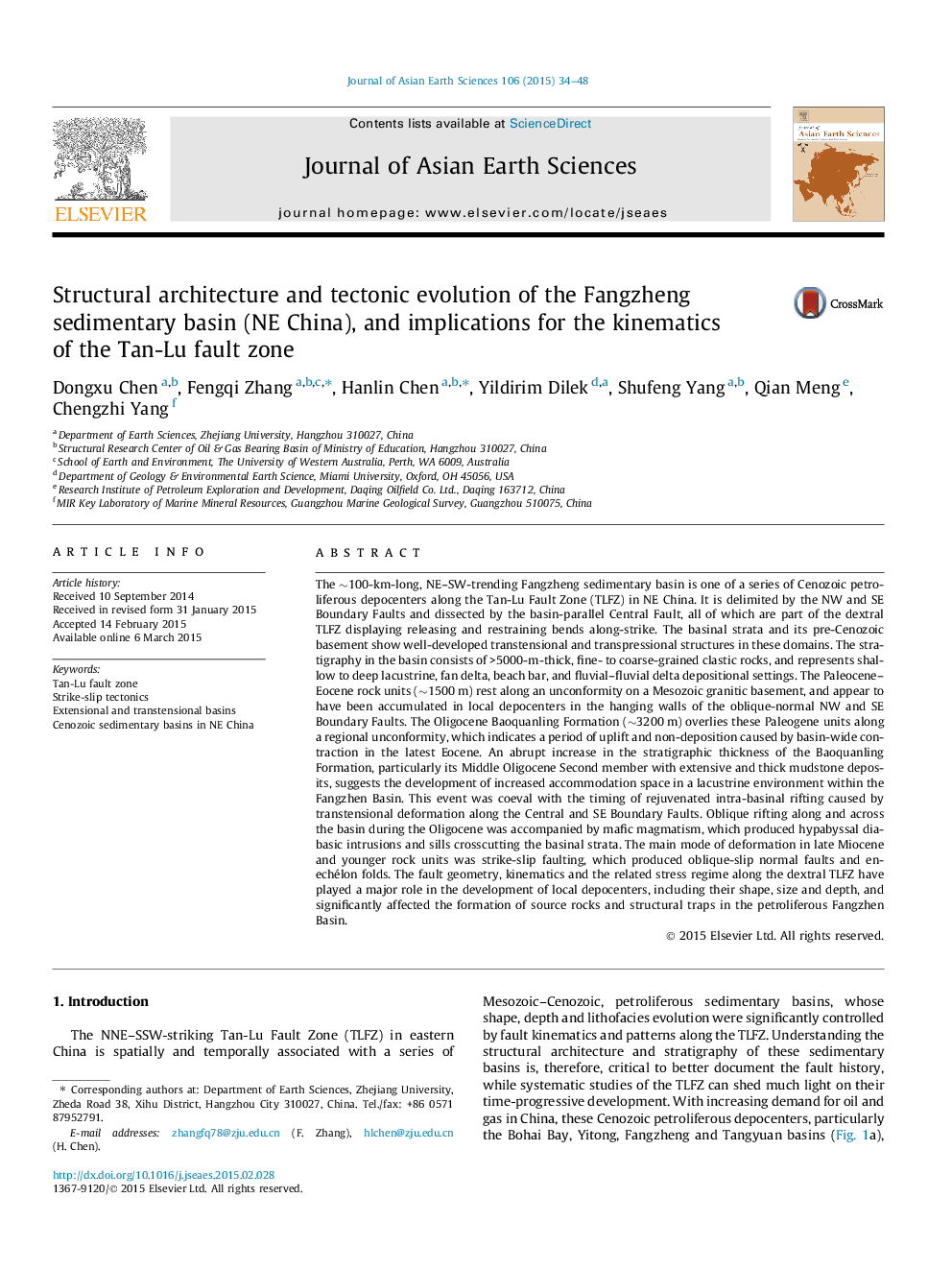| کد مقاله | کد نشریه | سال انتشار | مقاله انگلیسی | نسخه تمام متن |
|---|---|---|---|---|
| 6444268 | 1640363 | 2015 | 15 صفحه PDF | دانلود رایگان |
عنوان انگلیسی مقاله ISI
Structural architecture and tectonic evolution of the Fangzheng sedimentary basin (NE China), and implications for the kinematics of the Tan-Lu fault zone
دانلود مقاله + سفارش ترجمه
دانلود مقاله ISI انگلیسی
رایگان برای ایرانیان
موضوعات مرتبط
مهندسی و علوم پایه
علوم زمین و سیارات
زمین شناسی
پیش نمایش صفحه اول مقاله

چکیده انگلیسی
The â¼100-km-long, NE-SW-trending Fangzheng sedimentary basin is one of a series of Cenozoic petroliferous depocenters along the Tan-Lu Fault Zone (TLFZ) in NE China. It is delimited by the NW and SE Boundary Faults and dissected by the basin-parallel Central Fault, all of which are part of the dextral TLFZ displaying releasing and restraining bends along-strike. The basinal strata and its pre-Cenozoic basement show well-developed transtensional and transpressional structures in these domains. The stratigraphy in the basin consists of >5000-m-thick, fine- to coarse-grained clastic rocks, and represents shallow to deep lacustrine, fan delta, beach bar, and fluvial-fluvial delta depositional settings. The Paleocene-Eocene rock units (â¼1500Â m) rest along an unconformity on a Mesozoic granitic basement, and appear to have been accumulated in local depocenters in the hanging walls of the oblique-normal NW and SE Boundary Faults. The Oligocene Baoquanling Formation (â¼3200Â m) overlies these Paleogene units along a regional unconformity, which indicates a period of uplift and non-deposition caused by basin-wide contraction in the latest Eocene. An abrupt increase in the stratigraphic thickness of the Baoquanling Formation, particularly its Middle Oligocene Second member with extensive and thick mudstone deposits, suggests the development of increased accommodation space in a lacustrine environment within the Fangzhen Basin. This event was coeval with the timing of rejuvenated intra-basinal rifting caused by transtensional deformation along the Central and SE Boundary Faults. Oblique rifting along and across the basin during the Oligocene was accompanied by mafic magmatism, which produced hypabyssal diabasic intrusions and sills crosscutting the basinal strata. The main mode of deformation in late Miocene and younger rock units was strike-slip faulting, which produced oblique-slip normal faults and en-echélon folds. The fault geometry, kinematics and the related stress regime along the dextral TLFZ have played a major role in the development of local depocenters, including their shape, size and depth, and significantly affected the formation of source rocks and structural traps in the petroliferous Fangzhen Basin.
ناشر
Database: Elsevier - ScienceDirect (ساینس دایرکت)
Journal: Journal of Asian Earth Sciences - Volume 106, 1 July 2015, Pages 34-48
Journal: Journal of Asian Earth Sciences - Volume 106, 1 July 2015, Pages 34-48
نویسندگان
Dongxu Chen, Fengqi Zhang, Hanlin Chen, Yildirim Dilek, Shufeng Yang, Qian Meng, Chengzhi Yang,